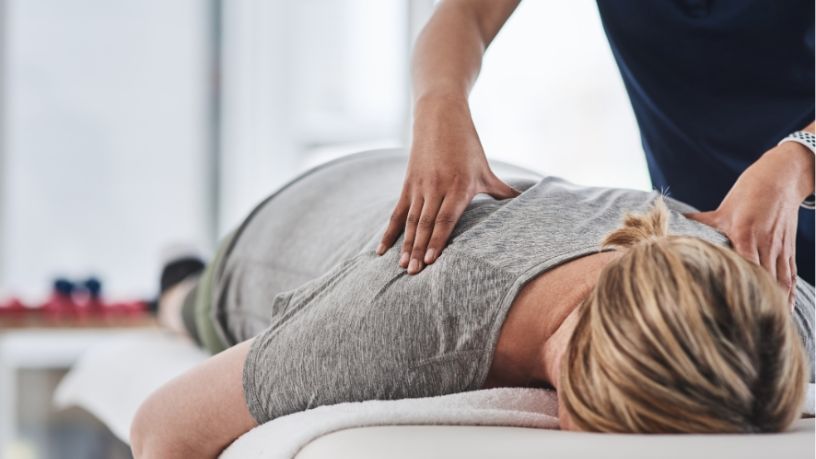On this page
Key takeaways
- Daily use of devices that mean we are looking down has increased neck pain among Australians
- Regular movement and gentle exercises can help reduce pain and prevent long term issues
- Make sure your desk is set up to support good posture and talk to a physio about how to maintain pain-free neck and shoulders.
If you’re reading this article on your phone, you’re probably looking down. The problem with that is that you could be in danger of developing a stress injury called ‘tech neck’.
Bupa physiotherapist Carly Stewart explains why tech neck is a growing problem and how you can prevent it.
What is tech neck?
Australians clock up about 6 hours a day on their devices,1 and all that time looking down has led to a modern stress injury known as tech neck, or tension neck syndrome.
Tech neck, also known as text neck or screen neck, is a repetitive stress injury caused by long periods of looking down and forwards. This position creates strain and stress on the neck and shoulder muscles, resulting in pain, stiffness or soreness.
“When we tilt our head forward to look at a phone or laptop, it increases the load on the muscles and joints of the neck and upper back,” says Carly.
For every few degrees forward, the head becomes effectively much heavier, leading to strain and overuse of those tissues.
It can also cause issues for your mid and lower back and lead to headaches.
The Australian Chiropractors Association recently reported that 64% of Australians are living with neck pain caused by overuse of devices, with women aged 31-40 most at risk.2
And it’s not just our phones that are to blame. Time spent on computers, laptops, gaming consoles and smartphones is contributing to the rise of tech neck.
How to prevent tech neck
Have a smart desk set-up
Being aware of your desk posture is key to reducing your risk of tech neck.
“A well-set-up workstation means your head is balanced over your spine, your shoulders are relaxed, and your lower back is supported,” says Carly.
“This reduces strain on the neck and shoulders and can prevent many common issues like headaches, neck pain, and even nerve irritation.”
Some simple rules to follow are:3
- Making sure your feet can sit comfortably flat on the floor.
- Keeping your screen at eye height so you aren’t looking up or down.
- Aligning your wrist and elbows with your keyboard so you don’t have to flex your wrists up or down while typing.
Take regular breaks
Staying in any position for too long can create strain and stress on your body, causing aches and pains.
Health and safety recommendations are to take short breaks from desk work of 5-10 minutes at least once every hour.4
For smaller devices that we tend to hold closer to our bodies, making the strain on our necks worse, experts suggest taking a break every 15 minutes.5
“Even a minute or 2 to stand up, stretch, or move around can make a big difference,” says Carly. “It helps reset your posture and gives muscles a chance to relax.”
Include some gentle stretches
Gentle neck side bends, looking side to side and shoulder rolls are excellent.
Have some tech-free time every day
For much of the working day we may need to be on a laptop, computer or phone. So, it’s even more important that when we can be device-free, we take the opportunity.
Avoid excessive scrolling in the evenings by putting your phone in another room and turning off notifications.
Occupy your hands with something else like making dinner or lunches for the next day, playing a card game with the kids or folding the washing.
Try leaving your phone inside when you’re in the garden or on a short walk with the dog.
And, if you are on a device, be mindful of how you’re holding it, says Carly. “Try to bring the device up to eye level rather than bending your neck down. If you’re reading or watching something longer, consider propping it up on a stand.”
Tech neck might be a modern problem, but with a few simple changes to your routine, you can make it a thing of the past.
Members First Network

At Bupa, trust is everything
Our health and wellbeing information is regularly reviewed and maintained by a team of healthcare experts, to ensure its relevancy and accuracy. Everyone's health journey is unique and health outcomes vary from person to person.
This content is not a replacement for personalised and specific medical, healthcare, or other professional advice. If you have concerns about your health, see your doctor or other health professional.
1Red Search. (2024). Australian mobile phone statistics 2024. Big Vision Marketing.
2Australian Chiropractors Association. (2025). New national survey reveals tech neck a growing public health concern [media release]. Australian Chiropractors Association.
3Mayo Clinic. (2024). ‘Tech neck’: Technology’s effect on your neck. Mayo Clinic Health System.
4Health and Safety Executive. Working safely with display screen equipment. UK Government.
5Cleveland Clinic. (2023). How your smartphone may be giving you ‘text neck’. Cleveland Clinic.
You might also like
5 types of knee pain
Knee pain can occur in multiple parts of your knee, or in localised areas. Learn about the different types of knee pain.
Understanding back pain: Causes, symptoms and treatment options
Learn what causes back pain, how to recognise symptoms, and your options for relief.
Frozen shoulder: Symptoms, causes and treatments
Frozen shoulder is a condition where your shoulder becomes painful and stiff. Taking painkillers and doing exercises can help ease your symptoms.
Rotator cuff injury: Symptoms, causes and treatment
Learn about rotator cuff injuries, symptoms, diagnosis and treatment options. Discover how to manage shoulder pain with tips from Bupa.





